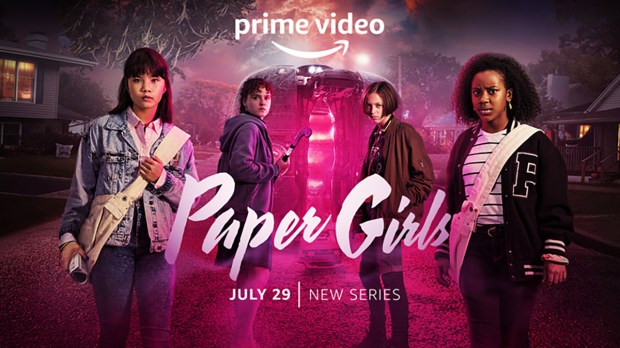They say if you travel far enough, eventually you meet yourself. The new Amazon Prime series Paper Girls takes that literally. Despite being outwardly science fiction, it takes us on a journey that is introspective and focused on the heart. It challenges us to imagine what it would be like if our child and adult selves really did have to face each other.
In the wee hours of the morning on All Saints Day, 1988, four 12-year-old girls set out on their bikes to deliver newspapers. Though they all live in the same small, sleepy suburb, their lives are very different from one another.
Erin (Riley Lai Nelet) is the eldest daughter of a Chinese immigrant, carrying the weight of having to interpret for her mother. Tiffany (Camryn Jones) is a brainy kid from a bi-racial family. Mac (Sofia Rosinsky) and KJ (Finna Strazza) both come from difficult family situations, yet Mac’s experience is tinged by abuse and neglect while KJ has grown up in a gilded cage of wealth, trapped by her mother’s impossible expectations. In the normal course of events, these girls would never have met or become friends, but because of their shared paper route they find themselves accidentally thrown together in a plot that involves time travel, a war for the fate of humanity, and the ordinary perils of growing up.
The show is adapted from the excellent comic book of the same name by Brian K. Vaughan and Cliff Chiang, and it is faithful to its source material in many ways. The personalities of the characters, the emphasis on friendship in the face of adversity, and even the color scheme all make it feel like the comic has come to life. Yet what makes the show stand out is the interaction between the girls and their future selves, something that also occurs in the comic but is not explored quite as extensively.
The girls discover that their adult lives are not what they had hoped or expected they would be. This leads to tension and even open arguments. “You are literally the worst version of myself I could have imagined,” 12-year-old Erin tells her early-40s counterpart. “You may think you know what you want but the truth is you have no idea who you even are,” adult Erin replies. “You’re a 12-year-old kid. I have DVDs older than you.”
This could easily devolve into moralizing or mere generational warfare, but the show wisely avoids neat answers. In the midst of their interactions –- and especially their conflicts -– it is easy to see the point of view of both adult and child. For example, child Tiffany glories at first in meeting her 23-year-old self, a smart, popular party girl who fulfilled the dreams of her younger self by graduating high school at the top of her class and going to MIT. But soon admiration turns to disappointment as Tiffany realizes that her adult self is stuck back in her old town, not doing anything constructive with her life, and seemingly hostile now to the dreams she once had. Twelve-year-old Tiffany is right to take her older self to task for her loss of ambition, reminding her, “These are my dreams, nobody else’s.” Yet at the same time, adult Tiffany speaks a truth that her younger self needs to hear when she says, “Right now you think all that success is going to make you whole, going to make you feel different, but I’m here to tell you, you’re just going to be you when you get there.” Both of them are holding up a mirror that the other desperately needs to see.
Throughout human history, we have struggled with understanding ourselves. In the modern era, when identity has become a buzzword, we seem more confused than ever about how to find meaning and purpose in our lives. “For what am I to myself without you, but a guide to my own downfall?” says St. Augustine in his Confessions.
It is God who makes us intelligible to ourselves. In communion with Him, we start to see who we really are and how the different parts of our lives relate to a larger truth, even and including the broken and messy bits of ourselves we do not like to face.
There is no hint of religion or spirituality in Paper Girls, but the complex web of interactions between the children and their adult counterparts points to a need we all have for something more than any of us can discover on our own. No version of ourselves, at any given point in time, is able to fathom the whole of who we are created to be. Only God, who sees us not within the limitations of time but as complete persons, can fully understand us.
Though it is a show about children, Catholic parents should be cautious about allowing kids to view it, both because of a great deal of swearing and because of some exploration of themes surrounding sexuality (though there are no nude scenes). But for adults, this is a fascinating show with many different layers to explore, reminding us that we cannot turn a blind eye to who we have been and expect to discover who we can become.


